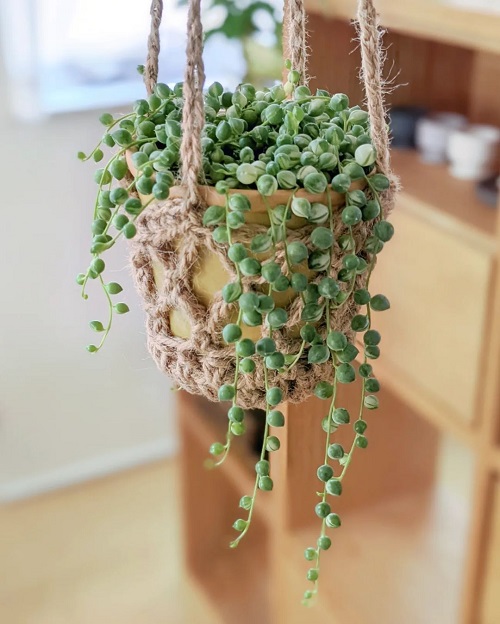Keep the jewel of your indoor garden robust and ecstatic with this extensive Variegated String of Pearls Care Guide!

True to its name, the widespread trailing succulent—Variegated String of Pearls has tiny, spherical leaves that resemble spotted pearls. This plant is a wonderful addition to any indoor or outdoor space and requires little maintenance. To flourish, it requires sufficient attention and care, just like any other plant. We will go through every aspect of caring for this lovely succulent in this Variegated String of Pearls Care Guide!
- Botanical Name: Curio rowleyanus
- Common Names: String of Pearls, Rosary Vines, String of Beads, String of Peas
- Features thin thread-like stems and fleshy round, bead-like leaves
- Mature height is 1.5-2 feet
- Flourishes well in full and partial sun exposure
- Toxic to humans and pets if ingested
Check Out Care Tips for String of Rubies here
Variegated String of Pearls Plant Profile
The South African native, Variegated String of Pearls, is a member of the Asteraceae family —a popular houseplant due to its unique appearance and ease of care. The plant features long vines holding small, round, bead-like leaves that typically look like strings of pearls cascading down the pot, hence the name. The beads are green in color, spotted with yellow or white flecks, adding to their charm.
Attaining a length of 1.5-2 feet, the trailing beauty looks fantastic in hanging baskets and high plant shelves where it can cascade down in glory. Apart from its aesthetic appearance, the succulent stands out with its low care requirements.
Ideal Pot Size
Pick a container that is just a little bit bigger than the plant’s root ball because a pot that is too big will pool water around the roots and affect the plant’s growth. Ideally, a 6-8 inches pot with enough drainage holes will do the job well. You may repot it to a bigger pot when you see the roots peeping out of the drainage holes. Also, picking a pot with drainage holes so that any extra water can drain away is crucial to plant growth.
Propagating Variegated String of Pearls Indoors

Propagating a String of Pearls using stem cuttings is the easiest way to multiply this trailing succulent.
- Get a healthy, disease-free plant and inspect a robust stem with enough leaves attached.
- Snip 4-6 inches long stem cuttings using sharp, sterile clippers and remove the leaves from the bottom.
- Leave only one to two sets of leaves at the top of the cutting after removing the lower sets.
- Let the cutting dry out and callus in a warm, dry environment.
- Plant the cutting in well-draining soil after the callus has developed, and water it lightly.
- Within a few weeks, roots will start forming if you place the pot in a bright spot with some indirect sunlight.
Variegated String of Pearls Requirements

Light
It prefers a setting with at least four hours of indirect, bright sunlight each day. Avoid giving intense exposure to prevent leaf scorching. Grow lights can be used to augment natural sunlight if your location doesn’t receive enough bright, indirect light. The plant can adapt to lower light levels as well. However, it will lead to leggy growth, compromising the plant’s appearance.
A West or South facing window can make up for the plant’s light requirements with a few hours of bright sunlight. In case you find the leaves scorching, move the plant indoors or drape a curtain to filter the intensity.
Soil
For Variegated String of Pearls, a soil mix that offers excellent drainage is a must. Get a sandy or gritty mix that’s specially designed for succulents and cacti. Aim for a slightly acidic soil pH level between 6 to 6.5 to ensure optimal growth.
A well-balanced soil mix should comprise equal parts of perlite, sand, pumice, and peat moss, providing the perfect blend of nutrients, aeration, and drainage. Alternatively, you may consider mixing an orchid mix with a handful of perlite as another option.
Water
You should only water your Variegated String of Pearls when the top inch of soil is absolutely dry. A typical issue with succulents is root rot caused by overwatering. The ideal method is to water the soil until it begins to leak out from the bottom of the pot and then let the extra water drain. Follow this process every week to maintain the right moisture balance in the medium.
Don’t allow the succulent to sit in standing water by any means.
Temperature & Humidity
Variegated string of pearls prefers a habitat that is warm and dry, with temperatures between 65°F and 80°F (18°C and 27°C). Avoiding drafts and abrupt temperature changes is crucial because these factors can stress and harm the plant. In order to promote blooming in winter, the plant may benefit from a somewhat cooler climate, with temperatures between 50°F and 60°F (10°C and 16°C).
The trailing succulent doesn’t require a lot of humidity. It can thrive well in typical household humidity. Misting the plant once or twice a week can help to boost the humidity surrounding the plant if the air is very dry.
Variegated String of Pearls Care

Fertilizers
Variegated string of pearls is a low-maintenance succulent plant that doesn’t require a lot of fertilization. However, applying a well-balanced liquid fertilizer every 4-6 weeks promote healthy growth and enhance its appearance.
Organic fertilizers, such as compost, worm castings, or fish emulsion, can be a good choice for the string of pearls. These fertilizers release nutrients slowly over time and can improve soil health and fertility. Throughout the winter, when the plant is dormant, avoid fertilizing.
Ensure to dilute the fertilizers to their quarter strength to avoid root burn.
Pest and Diseases
Variegated string of pearls, like the majority of indoor plants, is susceptible to pest infestations such as
- Spider mites: Webbing on the plant and yellowing or browning leaves are symptoms of a spider mite infestation. Use insecticidal soap or neem oil to get rid of spider mites.
- Mealybugs: Mealybugs appear as small, cottony white clumps on plants. You can spray the plant with a solution of rubbing alcohol and water (1:1) to get rid of mealybugs.
- Scale insects: Resemble tiny brown or black lumps on the stems and leaves of the plant. Use neem oil or an insecticidal soap solution to remove the infestation
- Fungal gnats: This group of tiny flying insects is frequently an indication of overwatering. To kill the larvae, you can also saturate the soil with a solution of Bacillus thuringiensis israelensis (BTI).






